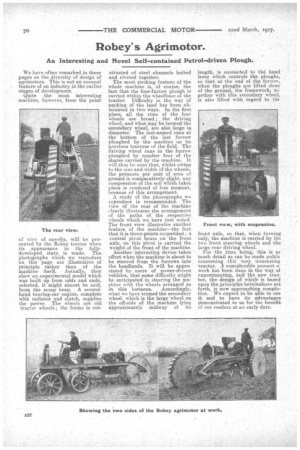Robey's Agrimotor.
Page 6

If you've noticed an error in this article please click here to report it so we can fix it.
An Interesting and Novel Self-'contained Petrol-driven Plough.
We have often remarked in these pages on the diversity of design of agrimotors. This is not an unusual feature of an industry in the earlier stages of development.
Quite the most interesting machine, hew.ever, from the point
of view of novelty, will be presented by the Robey tractor when its appearance in the fullydeveloped state is made. The photographs which we reproduce an this page are illustrative of principle rather than of the machine itself. Actually, they show an experimental model -Which was built up from odds and ends, selected, it might almost be said, from the scrap heap. A secondhand touring-car engine, complete with radiator and clutch, supplies the power. The wheels are old tracte,... wheels ; the frame is con
structed of steel channels bolted and riveted together.
The most striking feature of the whole machine is, of course, the fact that the four-furrow plough is carried within the wheelbase of the tractor. Difficulty in the way of packing of the land has been eliminated in two ways. In the first place, all the rims of the four wheels are broad ; the driving wheel,,and what may be termed the secondary wheel, are also large in diameter. The last-named runs at the bottom of the last furrow ploughed by the machine on its previous traverse of the field. The driving wheel runs in the furrow ploughed by number four of the shares carried by the machine. It will thus be seen that, whilst owing to the size and width of the wheels, the pressure per unit of area of ground isconiparatively slight, any compression of the soil which takes place is rendered of less moment, because of this arrangement
A• study of the photographs we reproduce is recommended. The view of the rear of the machine clearly illustrates the arrangement of the paths of the respective wheels which we have just noted. The front view illustrates another feature of the machine—the fact that it is three-points suspended; a central pivot bears on the front axle, on this pivot is carried the weight of the front of the machine.
Another interesting device takes effect when the machine is about to be steered from the furrows into the headlands. It will be appreciated by users of power-driven vehicles, that some difficulty might be anticipated in steering the machine with the wheels arranged as in this instance. Accordingly, _ what we have termed the secondary wheel, which is the large wheel on the off-side of the machine lying approximately, midway of its
length, is connected to the hand lever which controls the ploughs, so that at the end of the furrow, when the ploughs are lifted clear of the ground, the framework, to-. gether with this secondary wheel, is also lifted with regard to ilaf 'front axle, so that, when turning ' only, the machine is carried by the two front steering wheels and. the large rear driving wheel.
For the time being, this is as much detail as can be made publi( concerning this very interesting tractor. A considerable amount o: work has been-derie in the way of experimenting, and the new tractor, the design of which is based upon the principles, hereinabove set forth, is now approaching completion. We expect to be able to see it and to • have its advantages demonstrated to us for the benefit of our readers at an early date.




















